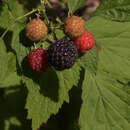en
names in breadcrumbs


Rubus leucodermis, also called whitebark raspberry or blackcap raspberry,[2][3] is a species of Rubus native to western North America.
Rubus leucodermis is a deciduous shrub growing to 0.5–2.5 metres (1+1⁄2–8 feet), with prickly shoots.[4] While the crown is perennial, the canes are biennial, growing vegetatively one year, flowering and fruiting the second, and then dying. As with other dark raspberries, the tips of the first-year canes (primocanes) often grow downward to the soil in the fall, and take root and form tip layers which become new plants. The leaves are pinnate, with five leaflets on the leaves' hardy stems in their first year, and three leaflets on leaves on flowering branchlets with white (and infrequently light purple) flowers.
The fruit is 1–1.2 centimetres (3⁄8–1⁄2 inch) diameter, red to reddish-purple at first, turning dark purple to nearly black when ripe.[5] The edible fruit[6] has high contents of anthocyanins and ellagic acid.[2][7]
R. leucodermis is similar to the eastern black raspberry (Rubus occidentalis).[7]
Bush in Nevada
Three varieties are recognized:[3]
The name leucodermis means "white skin", referring to the white appearance of the stems because of a thick waxy coating on the surface.
The species can be found from Alaska southward along the Pacific coast as far as California, Arizona, New Mexico, and Chihuahua.[8][9][10][7][11]
The plant forms natural hybrids with other species in subgenus Idaeobatus.
Rubus leucodermis, also called whitebark raspberry or blackcap raspberry, is a species of Rubus native to western North America.